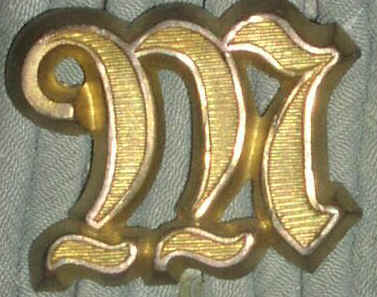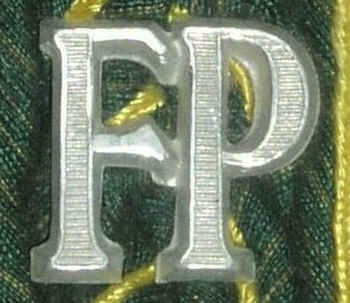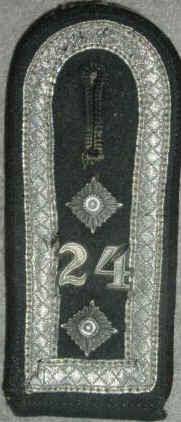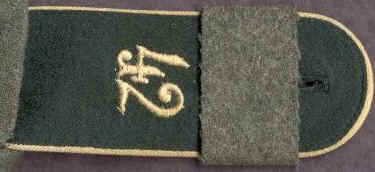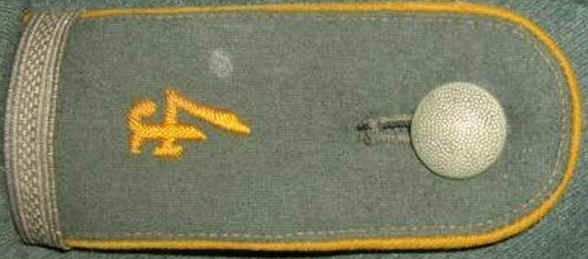David A. Suter for Wehrmacht-Awards.com
Rank / Branch / Unit Insignia
Rank pips;
Rank pips;
Rank was indicated by the use of square rank 'stars' or 'pips'. NCOs wore pips of silver or aluminum. Company and Field Grade officers wore gold colored rank pips. There were variations in sizes (Photo 30). General officers wore silver or aluminum colored pips of varying size, one choice being an oversize pip (Photo 31).
 |
| Photo 30 |
 |
| Photo 31 |
Field Marshals:
31b
31c
31d
Field Marshals used a device representing crossed Generalfeldmarschall
batons rather than rank pips to denote their rank. The devices were
executed in silver metal. There were two designs. The first design
was used from 1936 until 1941 (Fig. 31b). The second pattern
device was introduced on 27 September 1940 (Fig 31c). As noted
elsewhere, on 3 April 1941 the board design itself was changed by
specifying that the center silver cord be changed to gold. It is common
to find 2nd pattern batons on 1st pattern boards (Fig. 31d).
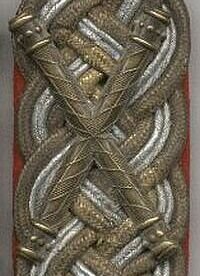
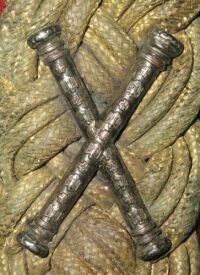
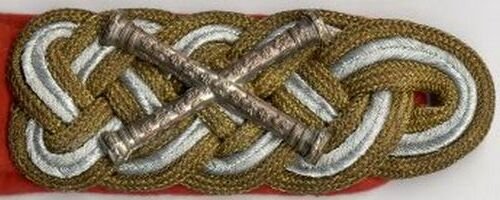
Waffenfarben;
The German Army used a system of colors to denote various branches. While this sounds simple, as a practical matter it is anything but. In the first instance, there is a wide variety of color variation within the individual colors. This is due to the fact that varying dye lots were used, as well as different materials. Add to that a ballpark figure of 60 years of sun, soil, misuse and abuse and the variance in shading becomes great. In my experience, the worst are the various 'reds' and 'greens'. There were 21 different prescribed colors/color combinations. Examples of most of these branch colors are shown in the various illustrations through the article. Therefore, I will only list them here. They were as follows:
| Color | Branch |
| Bright red | General officers, artillery |
| Crimson | general staff, veterinarians |
| Wine Red | Judicial |
| Bordeaux | Smoke Troops |
| Pink | Panzer |
| Orange red | Supplementary officers, Corps of Engineers, Military Police |
| White | Infantry |
| Black | Engineers * |
| Black/White | Panzer (Armor) Engineers |
| Light Green | Jäger (Light Infantry), Gebirgsjäger (Mountain Infantry) |
| Grass/Meadow Green | Schützen (Rifles) (until July 1942), Panzergrenadier (Armored Infantry) |
| Dark green | Officials |
| Golden Yellow | Cavalry |
| Lemon Yellow | Signals |
| Cornflower Blue | Medical |
| Light Blue | Transport, Administrative Service (TSD) |
| Violet | Chaplains |
| Light Brown | Signals (until 1936), Construction |
| Dark Brown | Officials (secondary color) |
| Copper Brown | Motorcycle |
| Light Grey | Propaganda, Reserve Officers, various officials |
| * Embroidered unit designators for Engineers was done in the black branch color but frequently had an additional white border (Photo 31a). | |
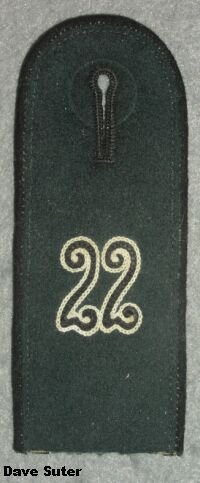
Photo 31a
Unit designators;
This is what makes the straps & boards so interesting. Without these designators all we would be left with are branch colors and ranks.
Individual units were identified by the use of numbers and, sometimes, letters or symbols on the straps & boards.
By regulation, these designators were embroidered for enlisted men and junior NCOs (Unteroffizier and Unterfeldwebel) and metal for Feldwebel and above.
The embroidered varieties were done in the wearer's branch color, with the metal devices in silver or aluminum for senior NCOs.
When an Unteroffizier got promoted to Unterfeldwebel it was a simple matter to add the NCO tress bar across the base of the strap.
This is frequently hand-stitched, especially on sew-in straps (Photo 32).
'Upgraded' straps are easily identified. Straps produced for the ranks of Unterfeldwebel and above will have the tress uniformly machine-sewn
(Photo 33).
In fact, after 24 January 1940 straps with unit insignia were no longer to be produced.
This order was largely ignored.
 |
| Photo 32 |
 |
| Photo 33 |
The embroidery can be divided into three classifications or styles.
The first is the standard chain-stitched variety (Photo 34). Those wishing to spend the extra money could have the embroidery done by hand
(Photo 35).
Some embroidery was also machine-stitched (Photo 35a).
 |
| Photo 34 |
 |
| Photo 35 |
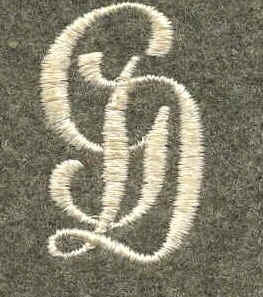 |
| Photo 35a S. Pritchett Collection |
Unit designators used on officer shoulder boards were of gold-colored metal.
The design was identical to that used on senior NCO straps.
Devices
The devices that were attached to the shoulder straps and boards were made of a variety of metals.
Early on they were made of thin brass. In late 1935 the material changed to a light metal, and in the later war years several other base metals were used, such as a zinc alloy.
In many cases the finish on these late war pieces has all but evaporated.
They were attached with prongs of a variety of designs; flat with beveled and blunt ends in both aluminum and brass, and round pointed brass being the most common.
In 1935 the basic design of the devices also changed. The Reichswehr devices were fairly flat with various diagonal chamfered patterns across the face
(Photo 36).
The new design was higher with a raised rim and horizontal lines (Photo 37).
Most insignia was produced in two sizes, and when used in combination the upper letter was supposed to be large while the lower was smaller
(Photo 38).
There are several categories that these devices can be divided into:
 |
|
| Photo 36 | |
 |
 |
| Photo 37 | Photo 38 W. Krawczyk Collection |
Letters;
They were usually of either Gothic (Photo 39) or Latin (Photo 40) design.
These devices could be a single letter, two letters struck together (Photo 41), or one letter superimposed over another
(Photo 42).
|
|
|
Photo 39 |
|
|
| Photo 40 |
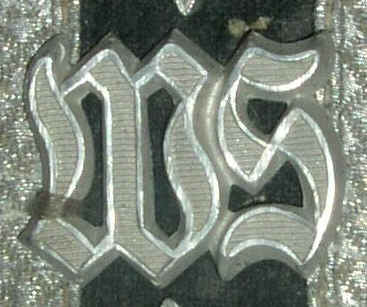 |
| Photo 41 |
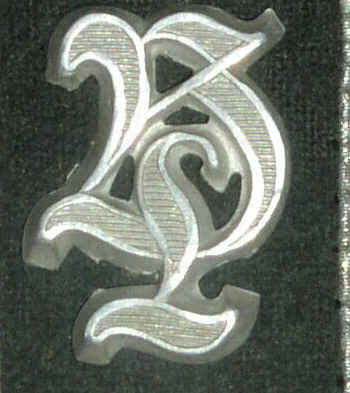 |
| Photo 42 |
Numbers;
Both Arabic and Roman numerals were used. In the case of Roman numerals they were struck as one piece (Photo 43). Arabic numbers of one or two digits could be in either the small (Photo 43a) or large size (Photo 43b). When 3 digits were used they were supposed to be of the small size (Photo 43c). However, these regulations were not always followed (Photo 43d).
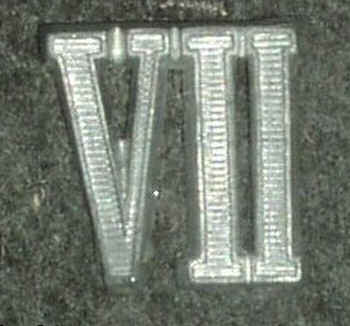 |
||
|
Photo 43 |
||
|
|
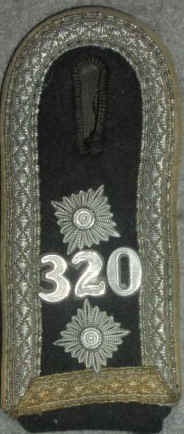 |
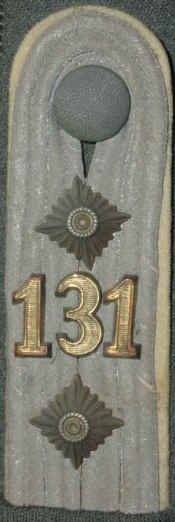 |
| Photo 43 a | Photo 43 b | Photo 43 c |
Symbols;
This last category comprises a number of different devices indicating with a branch of service or a particular unit.
| Caduceus - medical |
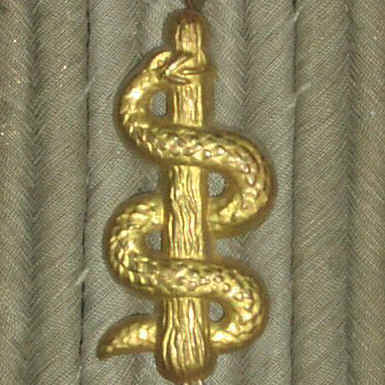 |
| Serpent - veterinary |
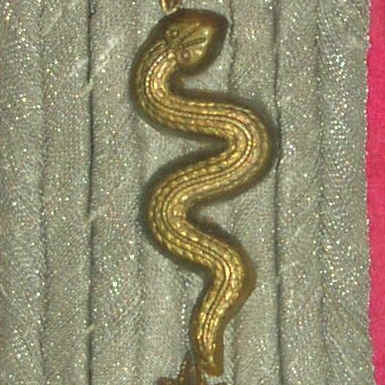 |
| Crossed cannon barrels - ordnance officers |
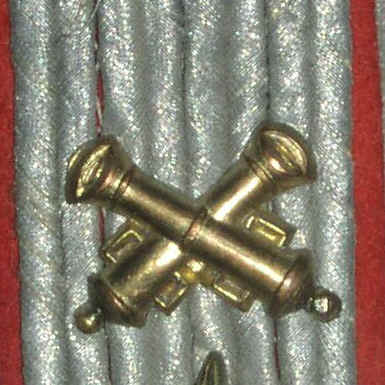 |
| Cogwheel - Corps of Engineers |
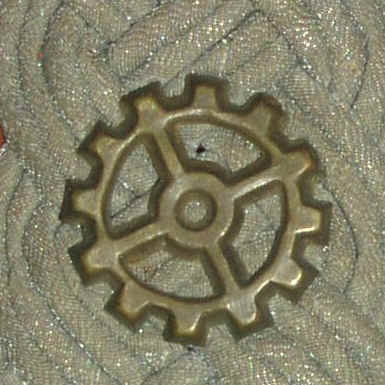 |
| Mercurian staff - Special Service officers |
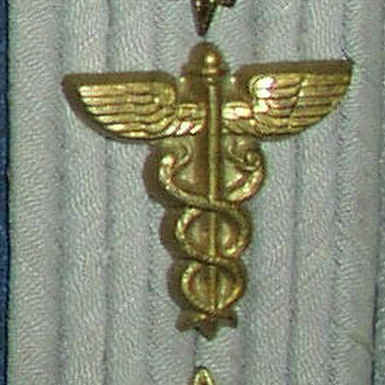 |
| Roman sword - Judiciary Corps |
 |
| Winged shell - Army Antiaircraft
D. Schreiber Collection |
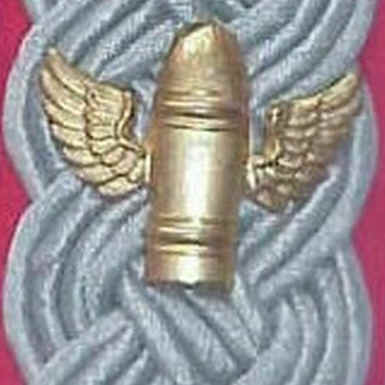 |
| Lyre - musicians |
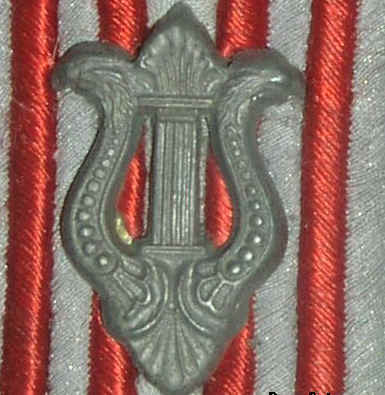 |
| Wehrmachtadler - War Administration Officials |
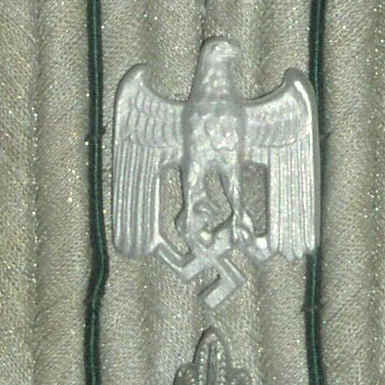 |
| Stalingrad' Cross - 'Hoch- und Deutschmeister' 44th Infantry Division; 134th Grenadier Regimen |
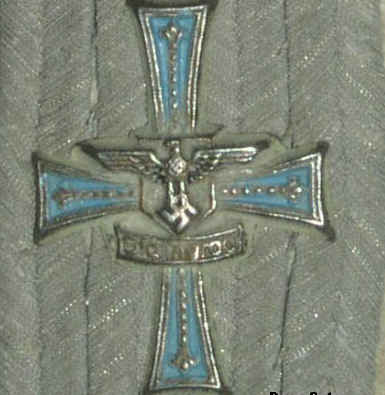 |
| Runic emblem - Feldherrnhalle |
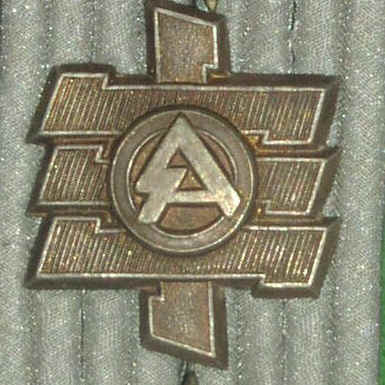 |
| Death's head - 5th Cavalry Regiment |
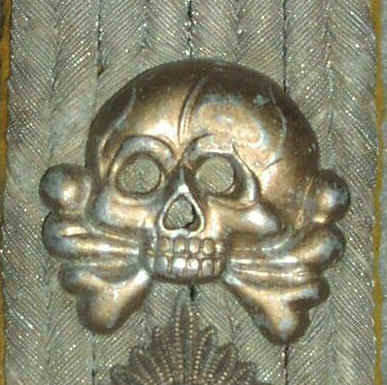 |
| Entwined GD - Grossdeutschland units |
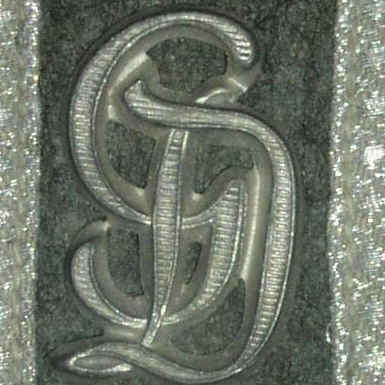 |
Shoulder strap slides;
In January 1940 the shoulder strap slide for enlisted personnel was introduced as a war-time economy measure, as well as for security at the front, as they were easily removed and/or discarded. These were made of field grey basic cloth and had the unit designator chain-stitched on. Initially the branch colors were used (Photo 56), but in May 1944 an order was issued that once existing stocks of colored thread were used up the embroidery was to be done in light grey (Photo 57).
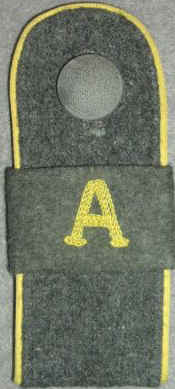 |
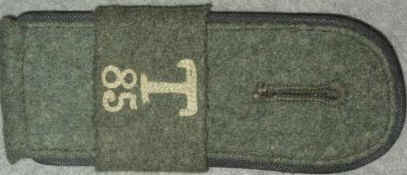 |
| Photo 56 | Photo 57 |
However, production and use of straps with embroidered and metal insignia never completely stopped.
Senior NCOs in particular continued to wear the metal insignia. In addition, these regulations changed several times.
Home-zone commands and schools were ordered not to order slides but instead use the original metal or direct-embroidery methods.
Camouflage cover slides: Directly related to the shoulder strap slides with unit designators were the camouflage slides.
There were produced for all ranks and were similar in construction except that they were 'blank.'
Intended to hide unit designators, they were seldom worn (Photo 57a).
|
|
|
Photo 57a |
NCO/Officer candidates;
Enlisted men who were NCO candidates wore a single loop of tress horizontally across the base of the strap (Photo 58). In October 1942 similar insignia was introduced for senior NCOs who were officer candidates. It consisted of two loops of tress worn across the base. In some instances this was made up of two separate loops sewn together (Photo 59). There also were produced two wider variations. Both gave the impression of double loops by having a center stripe. One variation has a black stripe (Photo 60) while the other is slightly wider with dark green center and border stripes (Photo 61).
|
|
| Photo 58 |
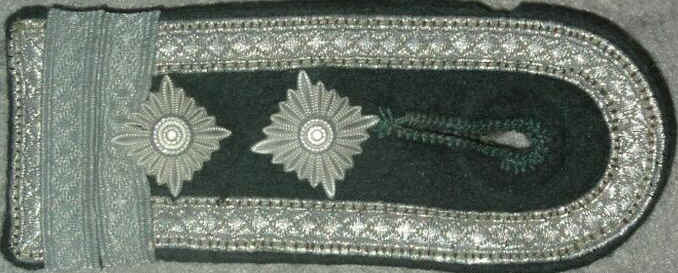 |
| Photo 59 |
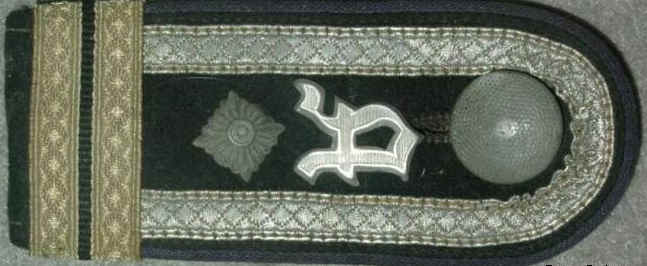 |
| Photo 60 |
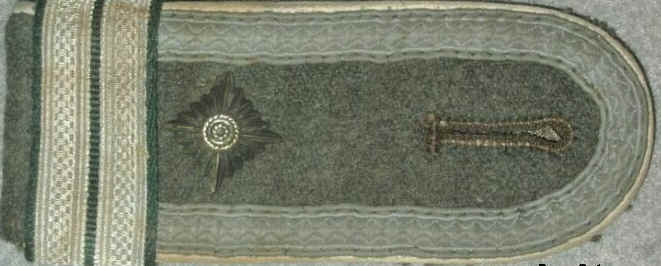 |
| Photo 61 |
Regimental designators;
Field unit designators were colored pieces of cloth that were attached to straps and boards as a means of ready visual identification.
These could be loops of cloth (Photo 62) or colored cording (Photo 63). They were also worn by officers
(Photo 64).
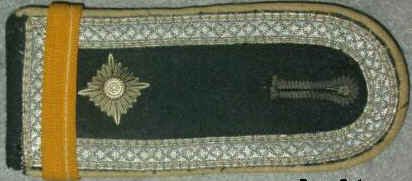 |
| Photo 62 |
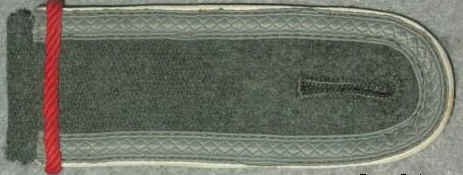 |
| Photo 63 |
 |
| Photo 64 |
![]()
© Copyright Wehrmacht-Awards.com LLC |

